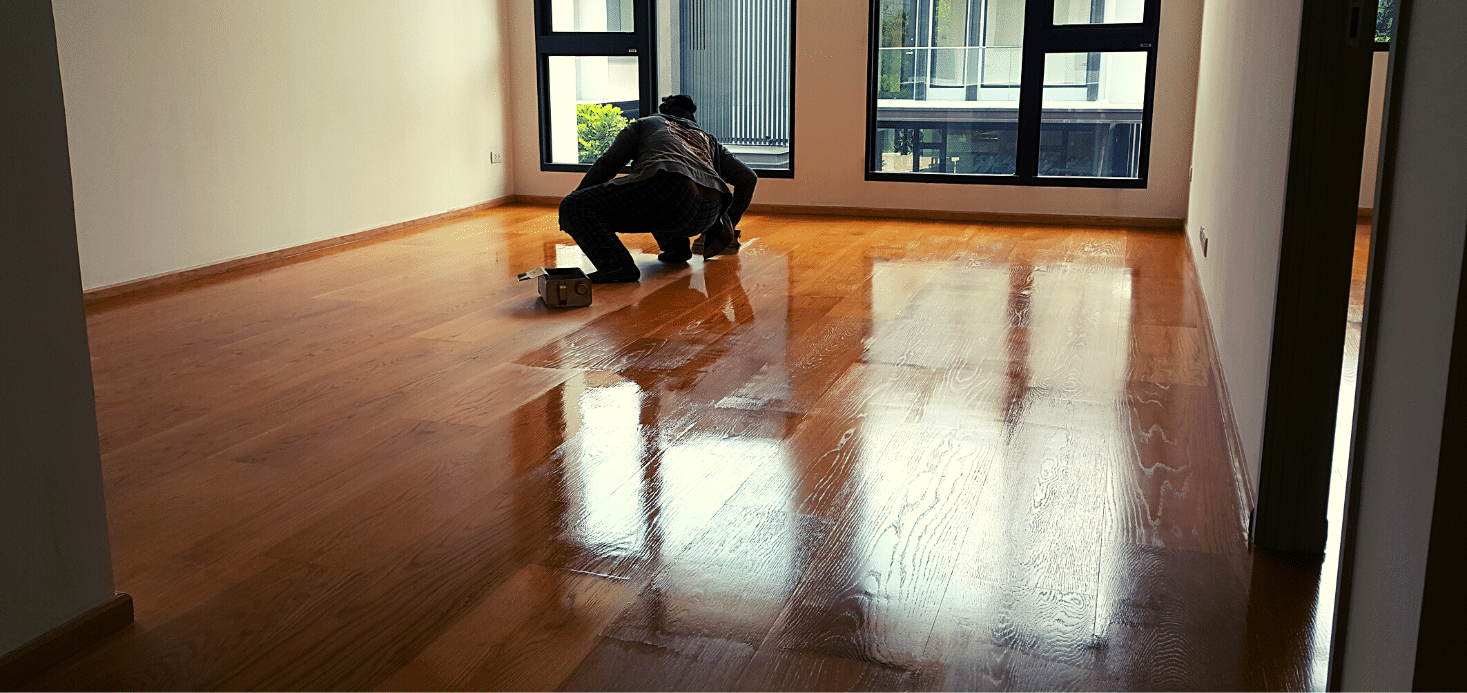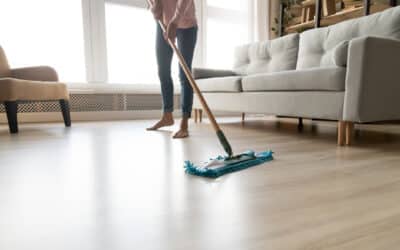The hardwood finish you use determines the look of your hardwood floor, its level of protection, the potential risks, and how you will maintain the floor over time. Knowing about the different types of hardwood floor finishes up front will help you choose the best option.
Every day, people select wood finishes with high expectations for how the floor is going to turn out. But in many cases, they realize something’s wrong after the finish cures. And the only way to fix it is to refinish the floor.
With an investment in hardwood flooring, you can’t afford to pick the wrong finish. The more you know about different types of wood finishes, the more confident you will be choosing the best one for your home or business. Without any regrets.
In this article, you’ll get a high-level overview of the different hardwood floor finishes available, and what we recommend for your home or business. By the end, you will know about the different wood floor finishes, including the three that typically work best, so you can be confident in the services, brands, and products you choose.
This article would not be possible without Jason Mack, who provided his expertise, answering questions about hardwood floor finishes.
The Different Hardwood Floor Finishes
- Moisture-Cure Urethane
- Acid Cure (Swedish Finish)
- UV-Cured Finish
- Waxes
- Shellac
- Aluminum Oxide
- Water-Based Polyurethane
- Natural Oils
- Oil-Based Polyurethane
An Overview of Wood Floor Finishes
Moisture-Cure Urethane
Moisture-cure urethane is a solvent-based hardwood floor finish that cures by absorbing moisture from the air. This ultra-fast drying, chemical-resistant wood finish provides maximum protection and the highest level of durability. It comes available in a gloss sheen.
Known as the toughest floor finish, moisture-cure urethane requires meticulous preparation and expert skill to apply. It’s difficult to lay down because humidity levels affect the rate of cure, so an even application can be a challenge.
Moisture-cure urethane is still used in certain parts of the United States, but it’s one of the nastiest finishes out there. It contains formaldehyde, which soaks into everything as it off-gasses. Even though it dries super-fast, it’s extremely toxic for the end user. To avoid skin exposure while applying it, you practically need to be wearing a hazmat suit.
If you have a fish tank in your home, you would need to remove it temporarily because the off-gassing vapors would kill all your fish.
This finish is also very flammable. The pilot lights and gas need to be turned off before application.
In the end, moisture-cure urethane is a highly effective but toxic finish. It’s durable but not significantly more durable than any two-component water-based hardwood floor finish. Most contractors avoid it because the negatives outweigh the positives.
Acid Cure (Swedish Finish)
Acid cure (Swedish finish) is an alcohol-based conversion varnish with great adhesion and an extremely durable, hard film.
More durable than polyurethane, acid cure finish is most often used on parquet flooring or on exotic wood species. Available in matte, satin, semi-gloss, and gloss, this finish dries fast but can take 30-90 days before it’s fully cured.
In the time it takes to cure, acid-cure finishes off-gas strong vapors with higher levels of VOCs than oil-based polyurethane. And like moisture-cure urethane, acid cure finish is flammable. Because of the toxic fumes, flammability, and long cure time, we don’t recommend acid cure finish for today’s home or business.
Glitsa, however, considers acid cure finish to be a low-maintenance solution offering unmatched protection.
UV-Cured Finish
On-site UV-cured finish is a transparent and water-carried finish for residential and commercial use with many of the same benefits as polyurethane finishes. The main distinction is that UV finish is cured by photo initiators. UV finish will remain wet until UV light is applied for an instant cure.
Here’s how it works: a contractor puts down 3 coats of finish. When the third coat is flashed off, a machine is carted onto the floor to shine UV light on the finish. The UV light cures the finish on contact, so the client can use the floor as soon as possible.
UV-cured finish has yet to take off because of the big up-front equipment cost and limited product selection. The equipment is heavy and expensive, and only two manufacturers make UV finishes (Loba and Professional Coatings). Finding contractors who offer these types of services can be difficult. You can find them here and there, but it depends on where you live.
Most contractors don’t think UV is worth it because water-based technology is rapidly improving. The cure rates of water-based polyurethanes are getting faster and faster with time. But if UV services are available in your area, they may provide the quality and speed you’re looking for in a finish.
Waxes
Wax has been used for centuries to protect hardwood floors. Available in paste or liquid, this light amber, low-sheen floor finish is spread in thin coats and needs to be reapplied frequently.
Wax is a traditional finish that’s not very durable or effective against liquids. Spilling water on the floor makes it very slippery and can cause white spots to quickly appear on the surface.
Contractors apply this finish when they want to preserve the floors of historic buildings and keep them correct to a specific era. That’s why you will find this finish coating the floors of an 1800’s government building.
Once you go with wax, maintenance becomes a time-consuming commitment. Many people find that the nostalgic appeal of wax wears off when they’re constantly working hard just to maintain the floor.
And refinishing a waxed floor is a difficult process. When you sand a waxed floor, the wax gums up the sandpaper. You also need to work extra hard to remove wax from the seams and cracks. If wax remains on the floor, other finishes won’t bond to the surface.
Shellac
Shellac is a finish created from the resin produced by the female lac bug. It became popular in the 1960’s, but these days, hardly anyone uses it as a hardwood floor finish. The only place to find shellac is in a paint or hardware store. None of the flooring product manufacturers offer it as a floor finish.
Aluminum Oxide
Aluminum oxide is a finish that’s used on prefinished flooring. It’s factory-finished only, so you can’t apply aluminum oxide onsite. As a finish, it has incredible durability.
Minerals in the finish make it tough. If you were to sand a floor coated with aluminum oxide, you would need special sandpaper to sand it successfully.
The Top 3 Most Popular Wood Floor Finishes
Water-based polyurethane, natural oils, and oil-based polyurethane are the top 3 wood floor finishes on the market today. Each type of finish has different advantages and disadvantages.
The best hardwood finish for you will depend on your goals relative to budget, sheen, color, durability, maintenance, and application.
NOTE: Before you choose a product, make sure you also know the sealer your finish is compatible with, so you can select the right finish system.
Water-Based Polyurethane
Waterborne (water-based) urethanes are transparent water-carried polyurethanes that are made using emulsions and additives. In the early 1990’s, water-based polyurethanes were a poor substitute for oil-based finish, but now the opposite is true. Water-based polyurethane has become the most popular wood floor finish.
The best finishes in this category are durable and quick to apply. They’re also better for the environment and indoor air quality with less VOC content.
But not all water-based polyurethanes have the same level of quality. You can buy cheap water-based polyurethanes, but they offer inferior protection compared to a higher-tiered product.
This finish is available in 1 or 2-component formulas. The 2-component solutions offer the highest level of durability and quality.
They give your floor a thin, hard shell. And they’re fully cured in 3 days to a week. Read more about why the best polyurethane is water-based.
- Price: $ – $$$
- Application: Fast drying time and cure with compliant VOC content levels; clean tools with water
- Sheen: Matte, Satin, Semi-Gloss, Gloss
- Color: Clear or amber, depending on the additives
- Protection & Durability: A thin coating forms over the wood and offers excellent protection up to 10-15 years, depending on the quality of the formula and application
- Maintenance & Repair: Easy to clean using a hardwood floor cleaner with a microfiber mop; scratches and wear show up in the coating and can’t be repaired without refinishing the floor
Water-Based Polyurethane Pro Tips:
- Adding clear, water-based finish to red oak can leave them looking lifeless. You will need to stain first to bring out the beauty of the wood. White oak, however, looks great with a coating of clear, water-based polyurethane.
- Water-based finish works perfect with Brazilian Cherry flooring because the red tones of the wood will darken naturally as time goes on.
- One way to avoid a plastic look is to use a two-component satin finish.
- If you want to color the floor, apply a stain before you lay the finish. Most water-based finishes will work over an oil-based stain. Always check and follow the manufacturer’s guidelines.
- White lines can occur in water-based finish when you apply it over a wet stain. If the stain isn’t dry, and you apply a water-based topcoat, a chemical reaction occurs because the stain is still off-gassing. The trapped gasses from the stain cause white lines to appear on the surface, and the only way to fix it is to refinish the floor. You can avoid this by allowing enough time for the stain gasses to evaporate before applying the finish.
Natural Oils
Natural oils are film-forming oils that penetrate wood surfaces to fill and surround the fibers for a natural appearance. They include hard wax oil and penetrating oil sealers. Natural oils contain different ingredients that vary by product and include tung, linseed, vegetable, and other oxidizing oils. Some products include small amounts of wax.
In the last ten years, natural oils have been rising in popularity because they’re durable, eco-friendly, and easy to maintain. Currently, they rank as the third most popular type of hardwood floor finish right behind oil-based polyurethane.
One benefit of natural oils is the many color options and colorant possibilities for aging effects. With so many different colors and effects to choose from, there’s endless opportunities for achieving a unique and beautiful shade. With natural oils, you also have a stand-alone finish. There’s no need for a sealer or stain.
Natural oils, especially hard wax oil, hold up well in residential and commercial spaces. They’re very popular in restaurants because of the quick turn around. With natural oils you can completely restore the floor or any section of it with a maintenance coat whenever necessary.
- Price: $$
- Application: Fast drying time and quick turnaround; eco-friendly with little to no vapors during application
- Sheen: Ultra-Matte, Matte, Satin
- Color: A wide range of color pathways, and you can mix colors to create any desired color
- Protection & Durability: Good overall protection and resistance with the ability to make spot repairs and to restore the surface, making it like new. When you properly maintain floors with this coating, you may never have to refinish your floors.
- Maintenance & Repair: Easy to clean using a special cleaner with a microfiber mop; scratches and wear can be repaired without refinishing
Natural Oil Pro Tips:
- A hard wax oil like Rubio Monocoat is very durable, even for water-prone areas, such as the kitchen and bathroom.
- Water-popping the floor makes the finish more durable.
- When you choose a color, remember that every wood species looks different with the same color.
- You don’t need to use raw wood cleaner to prepare the wood for natural oil unless you have an exotic wood species.
Oil-Based Polyurethane
A slow-drying finish that’s easy to apply, oil-based polyurethanes provide reliable durability and strong adhesion at an unbeatable price. Oil-based polyurethane is a transparent varnish dissolved in oil and enhanced with urethane.
Since the 1960’s, contractors have used it to coat and protect residential and commercial floors. Today, oil-based polyurethane is the second most popular type of hardwood floor finish.
One downside to oil-based polyurethane is that it’s a combustible solvent with a strong odor and high VOC-content, so it emits VOCs (less than moisture-cure urethane and acid cure) as it dries.
Another potential downside (depending on who you ask) is oil’s amber color. Once applied, oil will change the color of the wood, giving it a beautiful glow. But over time, the floor’s surface will take on an increasingly yellower shade, especially if it gets regular sunlight.
- Price: $
- Application: Slow drying time and cure with high VOC content; clean tools with mineral spirits or paint thinner
- Sheen: Matte, Satin, Semi-Gloss, Gloss
- Color: Amber color that’s initially beautiful but can become yellow over time
- Protection & Durability: A thin coating forms over the wood and offers excellent protection for 10+ years.
- Maintenance & Repair: Easy to clean using a hardwood floor cleaner with a microfiber mop; scratches and wear show up in the coating and can’t be repaired without refinishing the floor



